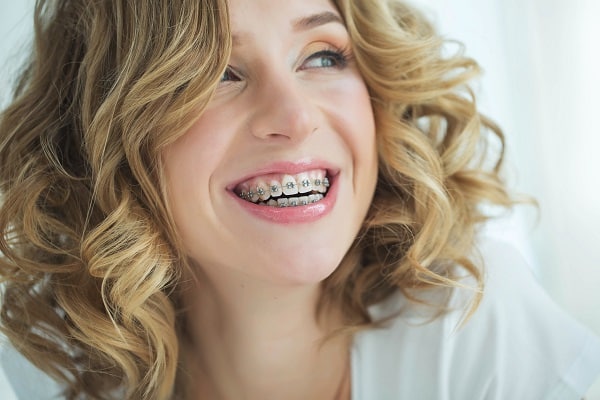Braces apply pressure over time to move teeth. As the teeth move, the bone in which they are embedded re-models and re-shapes to conform to the new position of the teeth. It takes time for braces to work. The exact amount of time varies by individual, depending on how the teeth need to move and the degree of misalignment.
The Mechanics of Braces

The goal of braces is to move your teeth into a more correct and functional position. Having a misaligned bite or teeth that are out of place not only affects your smile, but the way you chew and talk. Crooked teeth are also harder to clean, putting you at risk of developing cavities.
Traditional braces address these problems through the use of three basic components:
- Brackets
- Arch wire
- Bonding
The brackets are fixed to your teeth with bonding material, and the arch wire runs through each bracket, held in place by small rubber bands. The arch wire exerts a continuous pressure on your teeth, pushing and pulling them into a specific position over a long period of time.
Other types of braces are available for patients who do not want to deal with the inconvenient aspects of traditional braces. These options include Invisalign®, which uses clear plastic aligners that fit on your teeth similar to a mouth guard, and Incognito™, which are bracketed braces worn on the back side of your teeth.
When pressure is applied to your teeth, the membrane surrounding the roots of your tooth expands on one side and contracts on the other, making the tooth slightly loose. Once the tooth stops moving, bone grows around the membrane to support the new position. This movement must be accomplished extremely slowly in order to avoid complications, which is why braces must generally be worn for around two years, with adjustments made every three to four weeks.
What’s It Like to Wear Braces?
Our patients get used to the look and feel of braces after a couple weeks. Discomfort is normal after you visit the orthodontist for new wires and/or new rubber bands. That’s because pressure on the teeth is increased and/or exerted in a new direction when we make these adjustments. The soreness goes away about a day later. Most people have no problem relieving the discomfort with an over-the-counter anti-inflammatory.
Wearing braces does require you to care for them properly. They need to be flossed using a floss threader, which allows you to thread the floss underneath the arch wires. You’ll need to make sure you brush all sides of the brackets and wires so that food doesn’t linger there. While caring for braces may extend your brushing and flossing time slightly, it’s well worth it for great results in the end! We’ll make sure you get all the details about braces care when you visit our office.
Learn More About Braces
Braces are a time-tested method for straightening teeth that are more effective and less obtrusive than decades past. Whether you are a young adult or older adult, braces in the Denver area may be right for you. To learn more, and to arrange a consultation with experienced orthodontist Dr. Robert Rudman, please call our Cherry Creek practice at 303-331-0222.


